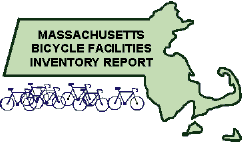
Next: Introduction
|
|
Top: MassPaths Home Page |
| Up: Short Table of Contents | |
| Previous: Full Table of Contents | |
|
Next: Introduction |
EXECUTIVE SUMMARYRecent increased interest in bicycling from cities, towns and regional planning agencies has resulted in an increasing number of submissions of proposals for bicycle facilities to the Massachusetts Executive Office of Transportation and Construction (EOTC). This interest reflects changing views of transportation planning, as well as changes in Federal funding mechanisms. The Bureau of Transportation Planning and Development (BTP&D) of the EOTC found that a statewide inventory of bicycle facilities proposals, as well as existing facilities, would be useful in order to create a context for review of new submissions and inquiries. The Massachusetts Highway Department (MHD) entered into a contract with the Bicycle Coalition of Massachusetts BCOM) to carry out the project This report, including maps, is one of two final products of the bicycle facilities inventory project conceived in 1994 by the BTP&D. The other product is a computer database listing existing and potential bicycle facilities. The goal of the process was to provide a comprehensive inventory of bicycle facilities projects to the BTP&D and to the 13 regional planning agencies (RPAs) in Massachusetts. The inventory process included three meetings in each RPA’s region. The first meeting was between project staff and RPA staff to discuss the project. The second and third meetings were open to the public. Public involvement was solicited through mailings to cities and towns, as well as to individuals and organizations with an interest in bicycling and transportation issues. The first public meeting was primarily for the purpose of receiving input, and the second one, for public review and comment. In addition, the inventory project’s scope of work included the task of defining a subset of proposed facilities projects as priority projects. Prioritization is based on criteria established by the BTP&D, incorporates initial suggestions by project staff, and reflects input at public meetings. The RPA’s choices governed when there were substantial differences of opinion about priorities. Priorities should be understood as only for the purpose of this project. Several of the RPAs are preparing planning documents which may reach different conclusions or set priorities based on different criteria. The majority of this report consists of a description of the existing and potential facilities in each of the 13 RPAs, followed by a short list of the priority projects. Cities, towns and the public participated strongly in the inventory project. The list of existing and proposed designated facilities for bicycle travel is substantially complete except for parking facilities, due to their very local and dispersed nature. The computer database which was submitted with this report contains detailed information on each project summarized in the report. In addition to the inventory and prioritization, project staff was asked to suggest cross-state bicycle routes. Four north-south routes, two-east-west routes and a number of side trips are indicated on the maps included with this report and described in a separate section of the report. The primary focus of these routes is to promote tourism and vacation travel. The cross-state routes emphasize historic and scenic locations and attractive bicycling locations, rather than directness alone. The following generalizations may be made from the input received:
During the course of this 8-month contract, BCOM conducted 38 meetings in all parts of the state, 13 meetings with representatives of all of the RPAs and two rounds of 15 public meetings. The first round was attended by a total of 255 people, and the second round by 203. More than 800 written suggestions were received from 260 commenters. Commenters included individuals, representatives of bikeway advocacy organizations and bicycle clubs, and RPA staff. The suggestion form included in an appendix to this report was the basis for most suggestions. |